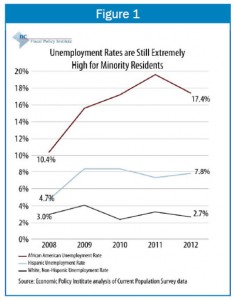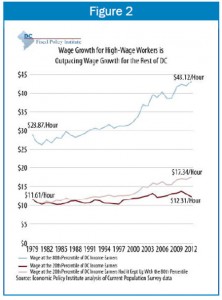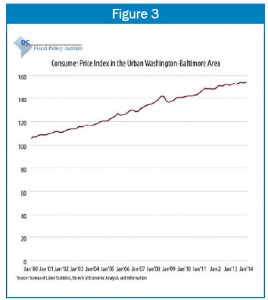Amidst the ups and downs of the DC economy in recent years — the Great Recession that may seem to some like a distant memory, the ongoing gentrification in more and more communities — some key stories emerge. DC is becoming a more expensive place to live, yet many residents live in poverty, unemployment is higher than before the recession started, and growth in wages has largely been confined to the top earners. These are key findings from the DC Fiscal Policy Institute’s “Quick Facts” on the DC economy. Here are four points that we think are especially important.
- Poverty affects one in five DC residents. For a family of three, that means living on less than $19,090 a year. Children under the age of 18 are much more likely to live below the poverty level than adults. And one in four black DC residents and one in five Hispanic DC residents live in poverty compared with under one in 10 white non-Hispanic residents. Read about poverty in DC.
- DC’s unemployment rate remains higher than before the recession. For many of DC’s residents, the economy has improved. But the District’s recovery has been uneven, and many groups–including minorities, young residents, and residents without college degrees — face far higher unemployment rates than before the recession began. Read more about unemployment in DC.
- The wages of low-wage DC workers have barely changed over the past thirty years, while wages for top earners have increased substantially. Wages have fallen for all but DC’s most educated residents, and wage inequality is now at the highest level on record.

- Consumers spent 42 percent more for everyday goods and services in 2013 than they did in 2000. The Consumer Price Index (commonly known as inflation) is a measure of the average change over time in the cost of typical goods and services. These cost increases show why increases need to be made to income through services like Temporary Assistance for Needy Families or through the minimum wage. Read more about the Consumer Price Index.
To print a copy of today’s blog, click here.

